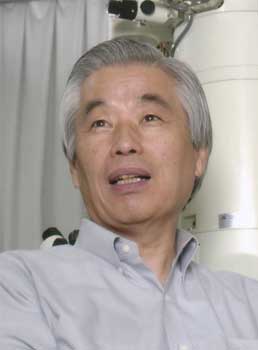Sumio Iijima
- Birthdate
- 1939/05/02
- Associated organizations
- Meijo University, NEC
- Fields of study
- Nanotechnology
- Awards
- Asahi Award, Japan Academy Prize, Agilent Technologies Europhysics Prize, Benjamin Franklin Medal in Physics
Biography
Sumio Iijima is a Japanese physicist best known for his discovery of carbon nanotubes. He graduated from the University of Electro-Communications in Tokyo in 1963, and received a doctorate in solid-state physics from Tohoku University in Sendai in 1968. Iijima is currently a Professor of Materials Science and Engineering at Meijo University in Nagoya, Japan. He is also a Research Fellow at the Fundamental Research Laboratories of the NEC Corporation, where he continues to research carbon nanotubes and their potential commercial applications.
After receiving his doctorate, Iijima briefly worked as a research assistant at the Research Institute for Scientific Measurements at Tohoku University. In 1970 he accepted a position at Arizona State University, where he worked as a researcher in the field of electron microscopy. As part of this work, he began studying the atomic structure of carbon. After returning to his home country in 1982, Iijima worked with the Research Development Corporation of Japan in the field of ultra-fine particles. In 1984 he discovered the structural instability of ultra-fine metal particles where, as he puts it, “the atoms of metal move about like amoeba.” From 1982 to 1987 he devoted his efforts primarily to research in this field.
Iijima began to work at the NEC Fundamental Research Laboratories in 1987. While there, he developed a program in advanced electron microscopy for the company, which in turn led him to return to his earlier interest in the atomic structure of carbon. In 1991 he discovered carbon nanotubes, which are tube-shaped materials whose diameter measures on the nanometer scale. Carbon nanotubes are now considered the fourth elemental form of carbon. (The other three are diamond, graphite, and fullerene molecules, such as buckyballs, which were first discovered in 1985.) In a recent article on Iijima, Business Week described carbon nanotubes as “a material invisible to the naked eye yet harder than diamonds and many times stronger than steel,” which are “likely to become a key building block for the 21st century.” Commercial applications for carbon nanotube technology potentially include light and incredibly strong industrial materials, tiny—yet very powerful—computer chips, compact batteries to power automobiles, and highly efficient power lines. Iijima also believes that carbon nanotubes may one day be used in nano-biotechnology applications, since “carbon itself has a high affinity with the human body.” Whether or not this comes to be, it seems clear that, as Iijima puts it, “as mass production of carbon nanotubes becomes possible, the material will undoubtedly play an important role in a wide variety of technical applications.”
Iijima has received a number of prestigious awards for his work. In 1976 he was awarded the Warren Diffraction Physics Award of the American Crystallography Society for his research in the field of electron microscopy, and in 1985 he was awarded the Nishina Memorial Award for his discovery of the structural instability of ultra-fine particles. For his discovery of carbon nanotubes and subsequent work in this area, he has received a wide variety of awards, including the Asahi Award, the Japan Academy Prize, the Agilent Technologies Europhysics Prize, and the Benjamin Franklin Medal in Physics, one of the world’s most prestigious scientific prizes.
